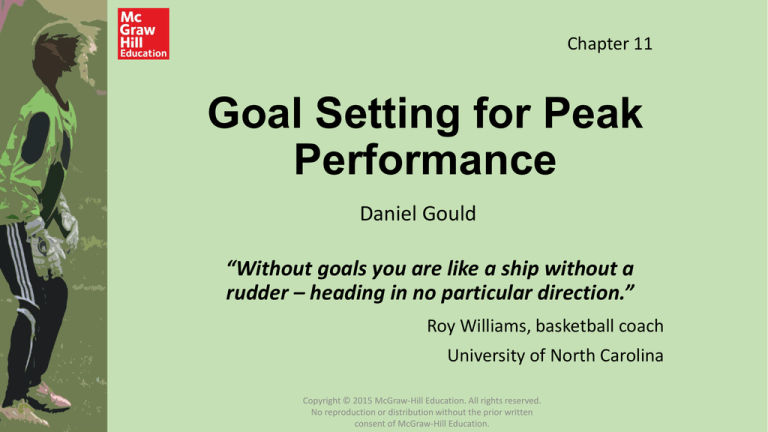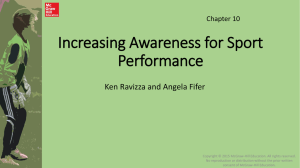
Chapter 11
Goal Setting for Peak
Performance
Daniel Gould
“Without goals you are like a ship without a
rudder – heading in no particular direction.”
Roy Williams, basketball coach
University of North Carolina
Copyright © 2015 McGraw-Hill Education. All rights reserved.
No reproduction or distribution without the prior written
consent of McGraw-Hill Education.
Introduction to Goal-Setting
• One of the most used techniques in applied sport
psychology
• Influences the performance of athletes of varied
age and ability levels
• Makes positive changes in psychological states like
anxiety, confidence, and motivation
• For goal-setting to be effective, coaches and sport
psychologists must its process and the factors that
affect it
Copyright © 2015 McGraw-Hill Education. All rights reserved. No
reproduction or distribution without the prior written consent of
McGraw-Hill Education.
Definition of a Goal
• Goal = an “objective or aim of action” that
attains “a specific standard of proficiency on
a task, usually within a specified time limit”
• Goal’s focus is on achieving some standard
• There are different kinds of goals
Locke and Latham
Copyright © 2015 McGraw-Hill Education. All rights reserved.
No reproduction or distribution without the prior written
consent of McGraw-Hill Education.
Types of Goals
• Outcome goals – standards of
performance that focus on the
results of a contest between
opponents or teams
• Performance goals – focus on
improvements relative to one’s
own performance
• Process goals –specify the
procedures the athlete must
engage in during performance in
order to perform well
Copyright © 2015 McGraw-Hill Education. All rights reserved.
No reproduction or distribution without the prior written
consent of McGraw-Hill Education.
Types of Goals (cont.)
• Team goals – Rather than aimed at individuals, these
goals set group goals to influence performance
• Some suggest that group goals have more
powerful effects than individual goals
Copyright © 2015 McGraw-Hill Education. All rights reserved.
No reproduction or distribution without the prior written
consent of McGraw-Hill Education.
Psychological Research on Goal-Setting
• Shows that goal setting consistently facilitates
performance
• 90% of the studies showed positive-partially
positive effects
• Also a successful technique for improving performance
and changing behaviors
• BUT these effects moderated by performance
feedback
• Goal-setting is most effective when customized to
particular settings and athletes
Copyright © 2015 McGraw-Hill Education. All rights reserved.
No reproduction or distribution without the prior written
consent of McGraw-Hill Education.
Athletes’ and Coaches’ Uses of
Goal-Setting
• More effective goal-setters use all types of goals
and productive goal-setting strategies
• To improve these coaches and athletes should
focus on:
•
•
•
•
Process-oriented performance goals
The relationship between long- and short-term goals
Skill and fitness goals
Implementing goals in practice and competition
Copyright © 2015 McGraw-Hill Education. All rights reserved. No
reproduction or distribution without the prior written consent of
McGraw-Hill Education.
But WHY does goalsetting influence
performance?
Copyright © 2015 McGraw-Hill Education. All rights reserved.
No reproduction or distribution without the prior written
consent of McGraw-Hill Education.
Mechanistic Theory
• Locke and Latham proposed that goals influence
performance in 4 ways:
1. Direct attention to important task elements
2. Help to mobilize effort
3. Increase effort immediately AND help prolong
effort/increase persistence
4. Goal-setters develop and employ new learning
strategies
• Factors (importance, self-efficacy, feedback, and task
complexity) impact the goal-performance
relationship
Copyright © 2015 McGraw-Hill Education. All rights reserved.
No reproduction or distribution without the prior written
consent of McGraw-Hill Education.
Cognitive Theory
• Proposed by Burton and looks specifically goalsetting in athletic environments
• Found that athletes’ goals are linked to their levels
of anxiety, motivation, and confidence
Copyright © 2015 McGraw-Hill Education. All rights reserved.
No reproduction or distribution without the prior written
consent of McGraw-Hill Education.
Cognitive Theory (cont.)
An athlete’s goal motivational orientation interacts
with perceived ability to produce one of three goal
styles
– Performance orientation: success defined by selfimprovement and has high perceived ability
– Success orientation: success defined by social
comparison and winning and has high perceived
ability
– Failure orientation: success defined by social
comparison and winning but has low perceived ability
Copyright © 2015 McGraw-Hill Education. All rights reserved.
No reproduction or distribution without the prior written
consent of McGraw-Hill Education.
Life Skills Goal-Setting Programs
• Focus is on identifying, learning life skills (like goalsetting), and then transferring the valuable life skills
learned in sport environments to general life
situations:
•
•
•
•
•
•
•
Identify a positive life goal
Focus on that goal’s process
Use of a general problem-solving model
Identify health-comprising behavior
Identify health-promoting behavior
Underline importance of good social support
Find ways to transfer skills from one life situation to
another
Copyright © 2015 McGraw-Hill Education. All rights reserved. No
reproduction or distribution without the prior written consent of
McGraw-Hill Education.
Goal-Setting Guidelines
• Set goals in measurable and behavioral terms
(explicit, specific, and numerical)
• Set moderately difficult, but realistic goals
• Set short-range AND long-range goals
• Set process, performance, and outcome goals
• Set goals for practice and competition
• Positive vs. negative goals
Copyright © 2015 McGraw-Hill Education. All rights reserved.
No reproduction or distribution without the prior written
consent of McGraw-Hill Education.
Goal Setting Guidelines (cont.)
• Set target dates for attaining goals
• Identify goal-achievement strategies
• Write goals down
• Provide feedback on goal achievement
• Provide support for goals
• Coach, Teammates, Family
• Set group goals
Copyright © 2015 McGraw-Hill Education. All rights reserved. No
reproduction or distribution without the prior written consent of
McGraw-Hill Education.
Goal-Setting System for Coaches
• Planning phase
• Identify individual and team goals
• Identify strategies to achieve goals
• Meeting phase
• Educate athletes
• Athletes should be involved
• Record goals
• Evaluate progress
Copyright © 2015 McGraw-Hill Education. All rights reserved. No
reproduction or distribution without the prior written consent of
McGraw-Hill Education.
Goal Setting System (cont.)
• Follow-up/Evaluation phase
• Schedule meetings throughout season
• Discussion among subgroups
• Provide feedback
Copyright © 2015 McGraw-Hill Education. All rights reserved. No reproduction or distribution without the
prior written consent of McGraw-Hill Education.
Common Problems
• Too many goals too soon
• Failing to recognize individual differences
• Setting goals that are too general
• Failing to modify unrealistic goals
• Failing to set process and performance goals
• Failing to understand the time-commitment
required in goal-setting
• Setting only technique-related goals
• Failing to create a supportive atmosphere
Copyright © 2015 McGraw-Hill Education. All rights reserved. No
reproduction or distribution without the prior written consent of
McGraw-Hill Education.








